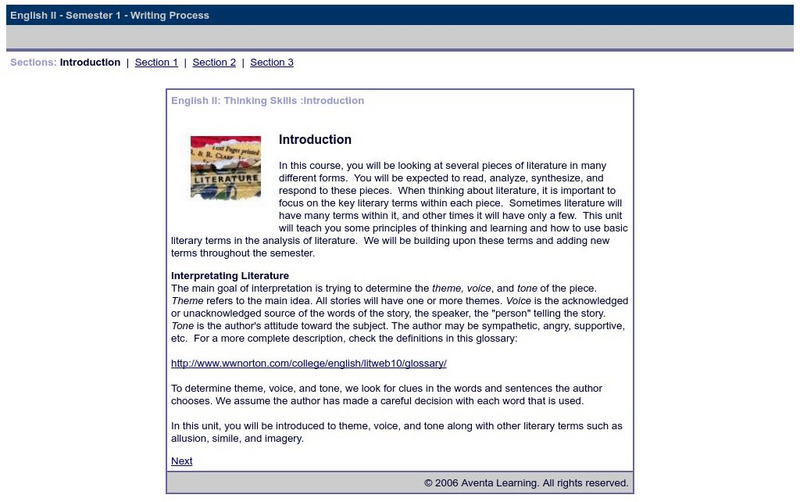TES Global
Blendspace: Idioms, Adages, Proverbs
A six-part learning module with links to texts and videos to use while learning about idioms, adages, and proverbs.
Alabama Learning Exchange
Alex: Producing Poetic Podcasts (Hey, That's Alliteration!)
In this culminating lesson for a poetry unit, learners will create a video podcast that summarizes a specific poem, analyzes the poet's use of literary elements, and infers the meaning of the poem (theme). The podcast must use a talk...
Other
Blinn College: Bryan Writing Center: Poetry Explication [Pdf]
Provides guidelines for analyzing poetry. Students must make certain they have a basic understanding of a poem, then analyze the language used. A set of 26 questions is offered that students can reference to help them analyze a poem....
Other
St. Edward's University: Devices: Assonance/consonance
Defines and compares the use of assonance and consonance in poetry, with examples.
PBS
Wnet: Thirteen: I Have a Metaphor
This instructional activity not only examines the message of Dr. King, but also the words themselves. This is a instructional activity in identifying the literary devices that he used in his "I Have a Dream" Speech. It will introduce the...
Sophia Learning
Sophia: Cliches: Lesson 1
This lessons introduces cliches and discusses their use. It is 1 of 4 in the series titled "Cliches."
ClassFlow
Class Flow: Onomatopoeias
[Free Registration/Login Required] Students will learn that onomatopoeias are words that imitate sounds. Using them can enhance writing and poetry.
Texas Education Agency
Texas Gateway: Literary Nonfiction
[Accessible by TX Educators. Free Registration/Login Required] In this lesson, you will learn how to analyze literary nonfiction, especially speeches, by making inferences and drawing conclusions based on evidence in the text. The...
Annenberg Foundation
Annenberg Learner: Syntax Store
The colors listed in the boxes represent different parts of speech: noun, verb, adjective, adverb, etc. Figure out which colors represent which part of speech and then use the colors to create proper sentences.
Department of Defense
Do Dea: Thinking Skills
In this self-guided course, you will be looking at several pieces of literature in many different forms. This unit will teach you some principles of thinking and learning and how to use basic literary terms in the analysis of literature....
ClassFlow
Class Flow: Metaphor & Simile
[Free Registration/Login Required] This flipchart helps students understand the use of metaphors and similes in written and spoken language. There are several fun examples, activities and whole group feedback using Activotes.




![Blinn College: Bryan Writing Center: Poetry Explication [Pdf] Activity Blinn College: Bryan Writing Center: Poetry Explication [Pdf] Activity](https://d15y2dacu3jp90.cloudfront.net/images/attachment_defaults/resource/large/FPO-knovation.png)






